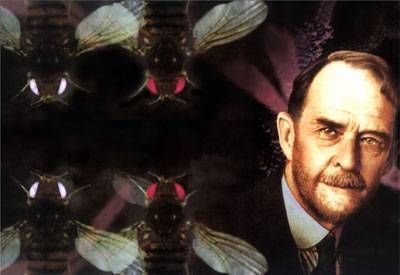Working with a kind of chemical clerk called a ribosome, RNA translates information from a cell's DNA into terms proteins can understand and act upon.
在一種核糖體的化學物質的幫助下,RNA將細胞里的DNA信息以蛋白質所能理解的形式翻譯出來并以此作為蛋白質行動的指令。
However, by the early 1900s, where we resume our story, we were still a very long way from understanding that, or indeed almost anything else to do with the confused business of heredity.
然而,在20世紀初,我們重新開始我們的故事的時候,我們還要走好長的一段路,才能理解這一點以及與遺傳撲朔迷離的現象相關的幾乎任何事情。

Clearly there was a need for some inspired and clever experimentation, and happily the age produced a young person with the diligence and aptitude to undertake it. His name was Thomas Hunt Morgan, and in 1904, just four years after the timely rediscovery of Mendel's experiments with pea plants and still almost a decade before gene would even become a word, he began to do remarkably dedicated things with chromosomes.
很明顯,有必要進行某種極富靈感的絕妙實驗。幸運的是,這時出現了一位足以承擔此任的勤勉而又才華橫溢的年輕人。他的名字叫托馬斯·亨特·摩爾根。1904年,也就是人們及時重新發現盂德爾的豌豆實驗僅僅4年之后,他開始致力于染色體的研究,而這時距基因這個詞的第一次出現,還要等上近10年的時間。
Chromosomes had been discovered by chance in 1888 and were so called because they readily absorbed dye and thus were easy to see under the microscope. By the turn of the twentieth century it was strongly suspected that they were involved in the passing on of traits, but no one knew how, or even really whether, they did this.
染色體于1888年被偶然發現,之所以這樣命名,是因為它們很容易被染上顏色,因此在顯微鏡下很容易看到。到了世紀之交的時候,人們明顯感覺到它們在傳遞某些特性中起到了一定作用,但是沒有人知道它們是怎樣起作用的,甚至有人對它們是否真正起作用也表示懷疑。
Morgan chose as his subject of study a tiny, delicate fly formally called Drosophila melanogaster, but more commonly known as the fruit fly (or vinegar fly, banana fly, or garbage fly). Drosophila is familiar to most of us as that frail, colorless insect that seems to have a compulsive urge to drown in our drinks.
摩爾根選擇了一種被稱為黑腹果蠅的小昆蟲作為實驗對象。這種昆蟲通常被稱為果蠅(或醋蠅、香蕉蠅、垃圾蠅)。這種果蠅纖弱,無色,在日常生活中很常見,似乎總是頻頻地迫不及待地一頭撞進我們的飲料中。












